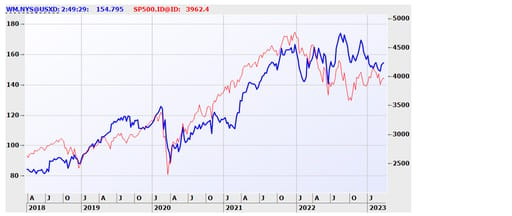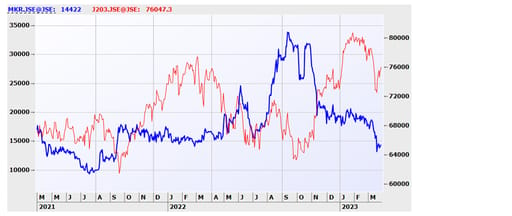
Responsible investing and sustainability are becoming increasingly important considerations for investors and investment managers alike.
This is due not only to changes in regulation but also to a new generation of investors who are conscious of the positive impact their investment can have beyond traditional metrics such as capital growth and income.
Being long-term investors, we acknowledge that as custodians of your wealth, we have the responsibility to invest and continue to invest in a way that promotes and aligns to long term sustainability.
Long-term investing requires an active and evolving approach, now more than ever. Environmental, social and governance (ESG) integration and a deepening approach to sustainability will remain a key investment priority for Investec Wealth & Investment.
This deepening approach to sustainability requires a systematic approach to the often complex problems. In this article, I focus on an example of such a complex problem, introducing a three-letter acronym: PFAs (Perfluoroalkoxy alkanes). PFAs are a group of manufactured chemicals that have been used in industry and consumer products worldwide since the 1940s. They have been used to make nonstick cookware, water-repellent clothing, stain resistant fabrics and carpets, some cosmetics, some firefighting foams, and products that resist grease, water and oil.
The most common PFAs are perfluorooctanoic acid (PFOA) and perfluorooctane sulfonic acid (PFOS). PFOA and PFOS have been phased out of production and use in the US, but other countries still manufacture and use them.
While PFAs are very useful, they have a major problem. During production and use, traces of PFAs can migrate into the soil, water, and air. However, most PFAs don’t break down, so they remain in the environment. Because of their widespread use and their persistence, PFAs are found in the blood of people and animals all over the world and are present at low levels in a variety of food products and in the environment. Some PFAs can build up in people and animals with repeated exposure over time.
Many scientific articles have been published that explore the impact of PFA exposure and the health effects that it can have. While it’s difficult to show that substances directly cause health conditions in humans, there have been scientific studies that show that exposure to some PFAs in the environment could be linked to harmful health effects in humans and animals. A review by the US Centers for Disease Control and Prevention (CDC) outlined a number of health effects associated with PFA exposure, including cancer, liver damage, decreased fertility, and increased risk of asthma and thyroid disease.
Regulators are starting to take action too. In the US, the Environmental Protection Agency recently proposed new requirements on communities to test water for the so-called forever chemicals, and to treat the water if the chemicals are found to be above certain levels.
The dangers of PFAs have been highlighted by Will Dichtel, a Professor of Chemistry at Northwestern University who has helped pioneer the development of porous polymers known as covalent organic frameworks.
A science paper on PFCA (perfluoroalkyl carboxylic acids) mineralisation and “forever chemicals” by Professor Dichtel (“Low-temperature mineralization of perfluorocarboxylic acids”, published in the journal, Science on 18 August 2022) featured in more than 250 media outlets shortly after its release.
Breaking down “forever chemicals”
PFA compounds are known as “forever chemicals” because they degrade slowly in the environment and accumulate in the body, with potential harmful effects on human and animal health.
PFAs can’t be broken down by bacteria, destroyed by fire or diluted by water. Instead, they break down slowly over time, posing a potential health hazard for generations to come.
Professor Dichtel and his team say they’ve found a cheap and effective way to break down two of the major classes of PFA compounds, leaving behind harmless end products.
The process uses two readily available chemicals — lye and dimethyl sulfoxide(DMSO) – to break down PFA compounds that are capped with carbon dioxide.
The process also works at a much lower temperature than previous efforts to break down PFAs compounds. The breakdown occurs at 120 degrees Celsius, 20 degrees above the boiling point of water, whereas earlier methods have required temperatures as high as 400 degrees Celsius.
“We were pleased to find a relatively low temperature, low energy input method where one specific portion of these molecules falls off and sets off a cascade of reactions that ultimately breaks these compounds down to relatively benign products,” said Professor Dichtel, in an article in (link to article that this quote comes from).
The substances that emerge out of the process of PFAs disintegration “are in many cases found in nature already and do not pose serious health concerns,” Dichtel said in (publication name).
PFAs are everywhere
The fact that PFAs don’t break down easily means that they have made their way from consumer goods and into the environment. PFAs chemicals can be found in the blood of 97% of Americans, researchers have found (article written by Alex Brown for The Pew Charitable Trust on 22 September 2022).
“These pollutants are pervasive throughout the world. They contaminate drinking water at low levels throughout the U.S. and in several places to relatively high levels, and this is true throughout the world,” Dichtel was quoted in an article from UC San Diego Health on 19 August 2022 – based on the paper titled “Low-temperature mineralization of perfluorocarboxylic acids” published in the journal, Science on 18 August 2022).
“Chronic low-level exposure to these compounds is associated with a number of health effects, including low birth weight, reduced immune response, liver damage, high cholesterol and many cancers,” Dichtel added. “And more of these health effects are emerging as the effects of this very large class of pollutants are continuing to be understood.”
Fine-tuning the breakdown process
Which is the most efficient process for breaking down PFAs? The researchers settled on one process and then managed to get it to degrade 10 different perfluoroalkyl carboxylic acids (PFCAs) and perfluoroalkyl ether carboxylic acids (PFECAs).
These include two of the most prominent PFAs compounds, perfluorooctanoic acid (PFOA) and one of its common replacements, known as GenX.
Dichtel and his team believe this process could be used to break down PFA chemicals found in drinking water, once those chemicals have been removed from the water supply and stored in a concentrated form.
The next step will be to find ways to make the process more efficient, possibly with different chemicals that would work at even lower temperatures.
Translating the results into real-world settings will be challenging, especially when it comes to disposal, in conditions that are different from those of a lab. PFAs have also deeply embedded themselves in air, water and soil across the planet, to such an extent that destroying them on a global scale remains a major undertaking.
A reality check
Those findings represent a major breakthrough in an area that has long proved elusive for scientists. PFAs were specifically designed so that they couldn’t break down, and that has unfortunately made them virtually impossible to address in the environment. While mechanisms do exist to extract them from, for example, drinking water, they still pose a major challenge when it comes to disposal.
Landfills also present major problems. Landfills are already full of PFAs, since these waste disposal sites contain everyday products like nonstick cookware and textiles.
There’s plenty of evidence to show that leachate, the liquid that comes out of landfills, carries PFAs into wastewater treatment plants, which then release the invisible contaminants into water bodies, ultimately bringing them into contact with drinking systems.
The problem is that PFAs cannot be disposed of safely. Even if PFAs are incinerated, the incinerators simply end up blowing the PFAs around the community in which the incinerator is located.
Dichtel’s latest research fits into a complicated series of steps for industry members who are grappling with the realities of the waste and water streams. Treatment technologies like reverse osmosis and granular activated carbon are already commonly used to remove PFAs from water. But once removed, the chemicals must again be disposed of, further perpetuating their presence in waste systems, unless they can be destroyed.
If the project were to be scaled up in its current form, the cost of the enormous quantities of DMSO required would be significant, as would be the disposal of the solvent. Taking into account these limitations, Dichtel says that the findings serve more as a starting point for disposing of PFAs, rather than an all-encompassing answer to the crisis.
Tackling waste management through investment
The disposal of PFAs and other potentially dangerous chemicals into the environment highlight the importance of investing in innovative waste management techniques that help reduce the harm caused to humans and other life forms.
As investors, we look for well-managed, high-quality companies that incorporate sustainability into their long-term strategy, since these are companies that are most likely to have enduring and market-leading profitability, while also helping to tackle some of humanity’s major problems.
On that note – I would like to introduce you to two companies that score well in terms of ESG.
Waste Management (WM-US) ($154.80) is a holding company, which engages in the provision of waste management environmental services in the US and Canada. WM provides collection, transfer, disposal services, and recycling & resource recovery. It also develops, operates and owns landfill gas-to energy facilities in the US. Its customers include residential, commercial, industrial and municipal customers. It also offers construction and remediation services, and services associated with the disposal of fly ash and in-plant services. The company was incorporated in 1995, has an annual revenue of $10.44bn, and net income of $2.25bn and a market capitalisation of $62.68bn. WM employs 48 500 employees. The company is covered by 20 analysts with an Overweight recommendation and a target price of $168.31. The forecast dividend yield to December 2023 is 1.8% and the forecast price/earnings ratio is 25.8x (FactSet consensus forecasts, 28/03/2023).

Source: FactSet, 28/03/2023
Montauk Renewables Inc. (MKR-ZA) (R144.22) engages in the recovery and processing of biogas from landfills and other non-fossil fuel sources for beneficial use as a replacement to fossil fuels. The firm develops, owns, and operates renewable gas projects. It operates through the Renewable Natural Gas and Renewable Electricity Generation segments. The company was founded in 1980 and is headquartered in the USA. The company has a market capitalisation of R20.93bn. The current price/earnings ratio is 34.9x and current price/book of 5.2x. The Return on Equity to December 2022 was 17.7%. The company reported full year results to 31 December 2022: Revenue +39%, EBITDA +158%, HEPS +1405% and NAV +23% compared to the prior year.

Source: FactSet, 28/03/2023
Sources of information cited in this article
- FactSet (American financial data and software company) (https://www.factset.com/)
- Dichtel Research Group (https://sites.northwestern.edu/dichtel/) - Low-temperature mineralization of perfluorocarboxylic acids
- E&E News (https://www.eenews.net/)
- ATSDR (Agency for Toxic Substances and Disease Registry) (https://www.atsdr.cdc.gov/)
- UC San Diego Health (19 August 2022 taken from the paper titled “Low-temperature mineralization of perfluorocarboxylic acids” published in the journal, Science on 18 August 2022). (https://myhealth.ucsd.edu/6,1657863563)
Receive Focus insights straight to your inbox
Disclaimer
Although information has been obtained from sources believed to be reliable, Investec Wealth & Investment International (Pty) Ltd or its affiliates and/or subsidiaries (collectively “W&I”) does not warrant its completeness or accuracy. Opinions and estimates represent W&I’s view at the time of going to print and are subject to change without notice. Investments in general and, derivatives, in particular, involve numerous risks, including, among others, market risk, counterparty default risk and liquidity risk. The information contained herein is for information purposes only and readers should not rely on such information as advice in relation to a specific issue without taking financial, banking, investment or other professional advice. W&I and/or its employees may hold a position in any securities or financial instruments mentioned herein. The information contained in this document does not constitute an offer or solicitation of investment, financial or banking services by W&I . W&I accepts no liability for any loss or damage of whatsoever nature including, but not limited to, loss of profits, goodwill or any type of financial or other pecuniary or direct or special indirect or consequential loss howsoever arising whether in negligence or for breach of contract or other duty as a result of use of the or reliance on the information contained in this document, whether authorised or not. W&I does not make representation that the information provided is appropriate for use in all jurisdictions or by all investors or other potential clients who are therefore responsible for compliance with their applicable local laws and regulations. This document may not be reproduced in whole or in part or copies circulated without the prior written consent of W&I.
Investec Wealth & Investment International (Pty) Ltd, registration number 1972/008905/07. A member of the JSE Equity, Equity Derivatives, Currency Derivatives, Bond Derivatives and Interest Rate Derivatives Markets. An authorised financial services provider, license number 15886. A registered credit provider, registration number NCRCP262.




